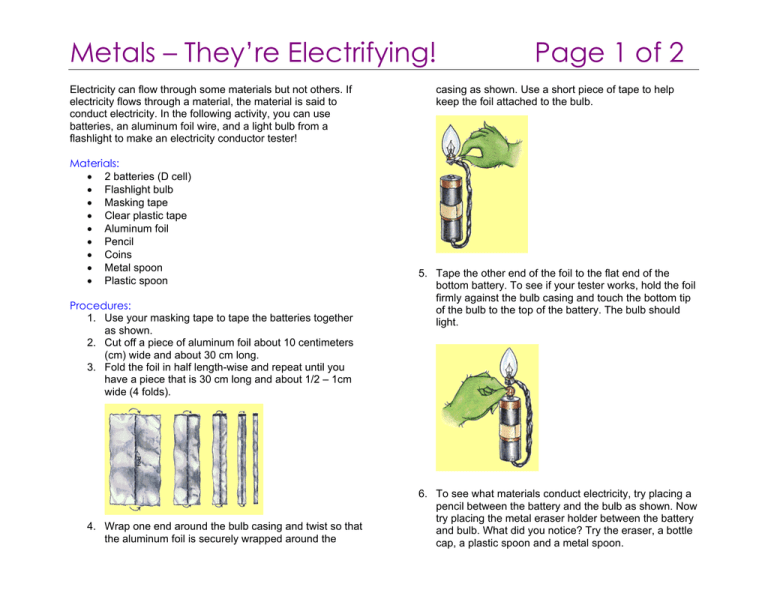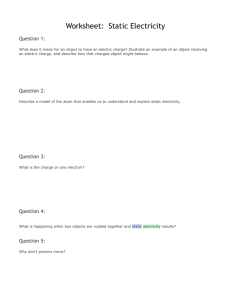Metals – They`re Electrifying! Page 1 of 2
advertisement

Metals – They’re Electrifying! Electricity can flow through some materials but not others. If electricity flows through a material, the material is said to conduct electricity. In the following activity, you can use batteries, an aluminum foil wire, and a light bulb from a flashlight to make an electricity conductor tester! Materials: • 2 batteries (D cell) • Flashlight bulb • Masking tape • Clear plastic tape • Aluminum foil • Pencil • Coins • Metal spoon • Plastic spoon Procedures: 1. Use your masking tape to tape the batteries together as shown. 2. Cut off a piece of aluminum foil about 10 centimeters (cm) wide and about 30 cm long. 3. Fold the foil in half length-wise and repeat until you have a piece that is 30 cm long and about 1/2 – 1cm wide (4 folds). 4. Wrap one end around the bulb casing and twist so that the aluminum foil is securely wrapped around the Page 1 of 2 casing as shown. Use a short piece of tape to help keep the foil attached to the bulb. 5. Tape the other end of the foil to the flat end of the bottom battery. To see if your tester works, hold the foil firmly against the bulb casing and touch the bottom tip of the bulb to the top of the battery. The bulb should light. 6. To see what materials conduct electricity, try placing a pencil between the battery and the bulb as shown. Now try placing the metal eraser holder between the battery and bulb. What did you notice? Try the eraser, a bottle cap, a plastic spoon and a metal spoon. Metals – They’re Electrifying! Think about this … You have seen that some materials are good conductors of electricity and some are not. Metals are generally good conductors. But materials that are not good at conducting electricity are also very useful. These materials are called insulators. Rubber, plastic, glass, and wood are all good insulators since electricity does not travel through them easily. Wires that carry electricity usually have plastic insulation around them. Also, the handles of metal tools usually are covered with rubber, plastic, or wood. Where's the Chemistry? The flow of electricity depends on the movement of extremely tiny particles called electrons. The electrons in metals move more easily than those in rubber, plastic, or wood. That's why metals are better conductors and rubber, plastic, and wood are better insulators. ©2008 American Chemical Society www.acs.org/kids Page 2 of 2 Science Activities for Children from the American Chemical Society The American Chemical Society develops materials for elementary school age children to spark their interest in science and teach developmentally appropriate chemistry concepts. The Activities for Children collection includes hands-on activities, articles, puzzles, and games on topics related to children’s everyday experiences. The collection can be used to supplement the science curriculum, celebrate National Chemistry Week, develop Chemists Celebrate Earth Day events, invite children to give science a try at a large event, or to explore just for fun at home. Find more activities, articles, puzzles and games at www.acs.org/kids. Safety Tips This activity is intended for elementary school children under the direct supervision of an adult. The American Chemical Society cannot be responsible for any accidents or injuries that may result from conducting the activities without proper supervision, from not specifically following directions, or from ignoring the cautions contained in the text. Always: • • • • • • • • Work with an adult. Read and follow all directions for the activity. Read all warning labels on all materials being used. Wear eye protection. Follow safety warnings or precautions, such as wearing gloves or tying back long hair. Use all materials carefully, following the directions given. Be sure to clean up and dispose of materials properly when you are finished with an activity. Wash your hands well after every activity. Never eat or drink while conducting an experiment, and be careful to keep all of the materials used away from your mouth, nose, and eyes! Never experiment on your own! For more detailed information on safety go to www.acs.org/education and click on “Safety Guidelines”. ©2008 American Chemical Society www.acs.org/kids

